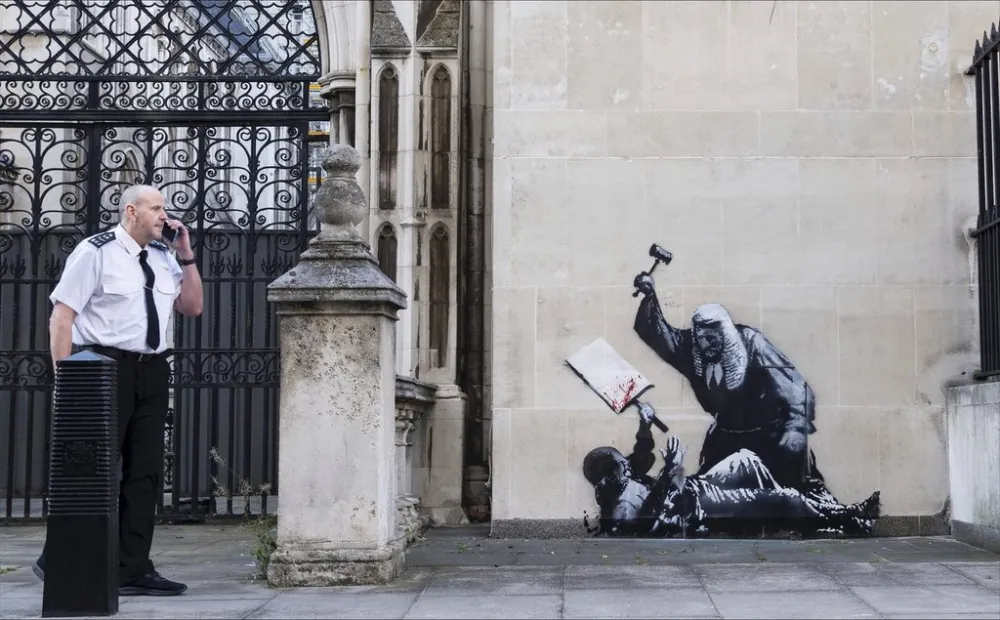Art has always been a mirror of society, often reflecting its struggles, contradictions, and injustices in ways words alone cannot capture. Few contemporary artists have mastered this balance between satire, politics, and provocation quite like Banksy. Known for his elusive identity and subversive style, Banksy has transformed public spaces into canvases for thought-provoking social commentary.
- The Rise of Banksy as a Cultural Icon
- The Artwork in Question
- Why the Removal Sparked Outrage
- The Broader Context: Protest and the Law in the UK
- The Value of Street Art as Social Commentary
- Economic and Cultural Impact of Banksy’s Works
- Public Opinion and Media Coverage
- Legal Questions: Vandalism or Free Expression?
- Possible Motivations Behind the Removal
- The Future of the Artwork
- FAQs
- Who is Banksy and why is he controversial?
- What did the Banksy artwork of the judge and protester symbolize?
- Why was the artwork removed from the court wall?
- Does removing Banksy’s art reduce its value?
- Has Banksy’s art been removed or destroyed before?
- What does this incident say about freedom of expression in the UK?
- Conclusion
Recently, controversy erupted in the United Kingdom after reports surfaced that a Banksy artwork depicting a UK judge striking a protester was quietly removed from the wall of a court building. This event has stirred debates about censorship, freedom of expression, the role of art in public spaces, and the uneasy relationship between institutions of power and voices of dissent.
At the heart of the story lies a question: was this artwork simply an act of vandalism that needed removal, or was it an important cultural statement that deserved protection? The answer is not straightforward, and as Britain grapples with broader discussions around justice, protest rights, and authority, the removal of Banksy’s work has taken on symbolic weight far beyond the brick wall it once adorned.
The Rise of Banksy as a Cultural Icon
To understand why this removal matters, it is essential to revisit the phenomenon of Banksy himself. Emerging from Bristol’s underground scene in the 1990s, Banksy became famous for his sharp stenciled graffiti, often layered with biting humor and piercing critiques of politics, war, consumerism, and authority.
His works—from the iconic “Girl with Balloon” to the dystopian amusement park installation “Dismaland”—are celebrated for their accessibility and their ability to spark debate in both the art world and everyday society.
Banksy’s anonymity only enhances his mystique. Unlike traditional artists who build their reputation through galleries and auctions, Banksy relies on surprise. His art appears overnight on bridges, walls, and alleyways, instantly commanding public attention. Over the years, his works have sold for millions, yet his ethos remains rooted in rebellion against elite control of art. That tension—between the establishment and the renegade—has defined his career. The recent incident at the UK courthouse perfectly encapsulates this ongoing clash.
The Artwork in Question
The piece at the center of the storm reportedly depicted a judge, complete with wig and robes, raising a gavel as if to strike down a protester lying beneath. The protester, painted with exaggerated vulnerability, symbolized the struggles of citizens confronting powerful institutions. For many viewers, the artwork conveyed a stark critique of Britain’s justice system and the perceived imbalance of power between the courts and ordinary people.
Placed directly on the wall of a court building, the image carried layered significance. It was not just commentary about the system but a direct confrontation with the physical embodiment of that system. By situating the artwork on the courthouse wall, Banksy blurred the line between protest and provocation, inviting the public to reflect on whether justice was being delivered or suppressed.
Why the Removal Sparked Outrage
When the news broke that the artwork had been removed, reactions were swift and divided. Critics of the decision argued that the removal amounted to censorship, stripping away an artistic statement that challenged authority. Supporters of Banksy’s right to be heard noted that the image represented the frustrations of thousands of Britons who have marched, protested, and been arrested in recent years over issues ranging from climate change to racial justice.
On the other hand, defenders of the removal argued that public buildings cannot simply become canvases for political messaging, especially messages that target the very institution within them. For them, the courthouse wall was not an appropriate stage for street art, no matter how iconic the artist.
This clash of perspectives highlights a deeper conflict: who decides what art belongs in public spaces, and what does it mean when powerful institutions erase critical voices from those spaces?
The Broader Context: Protest and the Law in the UK
The removal of this Banksy artwork cannot be separated from the broader political climate in Britain. In recent years, the UK has witnessed escalating tensions between authorities and protest movements. Climate activists from groups such as Extinction Rebellion and Just Stop Oil have staged high-profile demonstrations, often resulting in arrests and charges.
Meanwhile, the UK government passed the controversial Police, Crime, Sentencing and Courts Act in 2022, which granted authorities greater powers to restrict protests deemed disruptive.
For critics, these laws represent an erosion of civil liberties and a chilling effect on dissent. For supporters, they are necessary to maintain public order. In this context, Banksy’s image of a judge striking a protester resonates deeply. It taps into widespread concerns that the scales of justice are tipping against the public’s right to challenge authority.
The Value of Street Art as Social Commentary
Street art has historically been a tool of resistance, from anti-authoritarian graffiti during the Arab Spring to murals in Belfast reflecting the Troubles. In London and other UK cities, walls have long been spaces where the voiceless can make themselves heard. Banksy’s work is part of this tradition, offering subversive social commentary in a way that mainstream media and institutional voices often cannot.
Experts in art history argue that removing such works silences not just the artist but the community conversations they spark. According to Dr. Ruth Adams, a cultural studies scholar at King’s College London, “Street art is public debate made visible. Its power lies in its immediacy and its refusal to wait for permission. Erasing it is not a neutral act; it is an assertion of control over which voices are allowed to occupy space.”
Economic and Cultural Impact of Banksy’s Works
Beyond symbolism, Banksy’s works hold substantial economic value. Cities like Bristol and London have turned Banksy murals into tourist attractions, boosting local economies. Property owners often scramble to preserve his art, knowing it can increase a building’s value exponentially. Some works have been extracted from walls and sold at auction for millions.
The courthouse removal raises questions about whether the artwork was destroyed, preserved, or perhaps transferred to private ownership. If it has been preserved, it may one day reappear in a gallery, stripped of its original context. If it has been destroyed, it reflects a profound loss not just for art lovers but for cultural memory.
Public Opinion and Media Coverage
Media outlets and social platforms lit up with debates after the removal. Some commentators called it “a modern act of iconoclasm,” while others dismissed it as “a necessary step to maintain the dignity of the courts.” Polls conducted by local papers showed a generational divide: younger Britons overwhelmingly supported keeping the artwork in place, while older respondents were more likely to support removal.
Social media platforms amplified the controversy, with hashtags demanding the return of the artwork trending on Twitter and Instagram. This digital uproar demonstrates how Banksy’s works, even when erased, continue to provoke dialogue and mobilize communities worldwide.
Legal Questions: Vandalism or Free Expression?
One of the core questions surrounding the case is whether Banksy’s piece should be considered vandalism. Legally, graffiti on public buildings without permission often falls under vandalism statutes. Yet, when the creator is a globally renowned artist whose works are worth millions, the line blurs.
Courts in the UK have historically struggled with this paradox. While graffiti artists are often prosecuted, councils sometimes take steps to preserve Banksy’s works, even installing protective glass over them. This selective approach reveals the difficulty of reconciling cultural value with legal frameworks.
Possible Motivations Behind the Removal
Speculation abounds about why the artwork was removed. Was it an administrative decision by court officials seeking to preserve the building’s neutrality? Was it a political move to silence criticism of the judiciary? Or could it have been a preemptive effort to protect the artwork from vandalism or theft? Without transparency, the mystery only fuels further controversy.
Whatever the motive, the removal underscores how institutions interact with dissent. Even if the intention was to protect the building, the act symbolically aligns with the imagery Banksy depicted—authority striking down protest.
The Future of the Artwork
As of now, the fate of the piece remains uncertain. If preserved, it may find its way into a museum or private collection, where its meaning will inevitably shift. Displayed behind glass, it risks losing its edge as a rebellious statement of protest. If destroyed, it becomes a legend, remembered only through photographs and collective memory. Either outcome raises questions about who gets to control the narrative of public art.
FAQs
Who is Banksy and why is he controversial?
Banksy is an anonymous British street artist known for his satirical and politically charged graffiti. He is controversial because his works often appear illegally on public and private property, yet they carry significant cultural and financial value.
What did the Banksy artwork of the judge and protester symbolize?
The image of a judge striking a protester symbolized concerns about the imbalance of power between Britain’s justice system and citizens, particularly in the context of restrictive protest laws and increasing arrests of activists.
Why was the artwork removed from the court wall?
The exact reason remains unclear. Some suggest it was removed to maintain the neutrality and dignity of the court building, while others believe it was an act of censorship against a powerful political statement.
Does removing Banksy’s art reduce its value?
Not necessarily. While removal from its original context may strip the work of some meaning, preserved pieces often fetch high prices at auction. However, destruction of the piece would eliminate both its financial and cultural value.
Has Banksy’s art been removed or destroyed before?
Yes. Several of Banksy’s works have been painted over, demolished along with buildings, or removed for preservation. Each incident sparks debate over whether the works should remain in public view or be safeguarded as valuable art.
What does this incident say about freedom of expression in the UK?
The removal highlights ongoing tensions between artistic freedom and institutional authority. It raises questions about whether dissenting voices can be expressed freely in public spaces or whether they will be suppressed under legal and bureaucratic pressures.
Conclusion
The removal of Banksy’s artwork depicting a UK judge striking a protester is far more than a dispute about graffiti. It is a reflection of deeper struggles over freedom of expression, the right to dissent, and the power of institutions to shape public narratives. Banksy’s art has always thrived on provocation, and this latest controversy demonstrates how even its absence can spark urgent conversations.
Whether seen as vandalism or visionary critique, the piece has already achieved its purpose: forcing society to confront uncomfortable truths about justice, authority, and who gets to decide what voices are visible in the public square.







